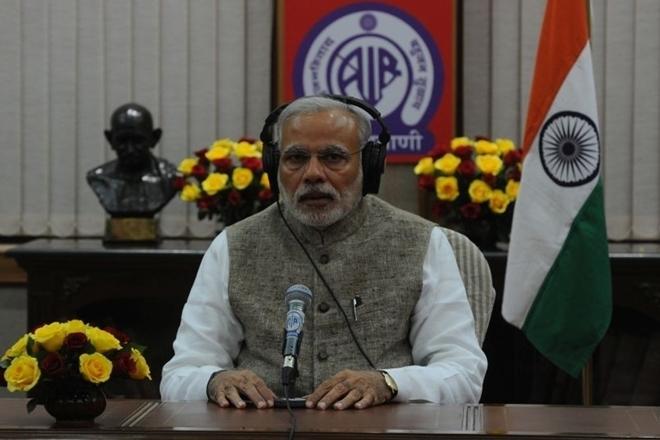PM Modi’s ‘Mann ki Baat’ Not Well Received by Non-Hindi Speaking TV Audience

This story is the second and final part of a report done by NewsClick on people’s response to the much hyped ‘Mann ki Baat’ programme hosted by Prime Minister Narendra Modi, based on an RTI reply.
Prime Minister Narendra Modi relied heavily on his monthly radio broadcast – ‘Mann ki Baat’ – to communicate with the Indian mass, but in reality the telecast of his show on different TV news channels failed to engage audiences outside the Hindi heartland.
As per the Broadcast Audience Research Council (BARC), which provides India’s TV viewership data, the TRP of the programme aired on November 29, 2015, on DD National – the state-owned Hindi language general entertainment television channel in India – registered an all time high at 1,601.
The rest five top TRPs of the 20-minute programme in the past four years were recorded at 1,032 (December 27, 2015), 975 (October 25, 2015), 1,290 (January 31, 2016) and 1,423 (February 28, 2016). A total of 50 episodes of ‘Mann ki Baat’ were aired in the past five years.
All these high TRP shows were telecast by DD National in Hindi language on Sundays that establishes that it was most watched in Hindi belt of rural India. The Bharatiya Janata Party (BJP) had asked its booth-level workers to watch or listen to the prime minister’s monthly address to the people in large numbers on TV, radio and FM and also encourage people to do the same.
Several BJP leaders had reportedly distributed radio sets among the party workers so that they can listen to the prime minister and also make others listen to him. There were reports that the programme was imposed, and school teachers and students were asked to overstay to watch ‘Mann ki Baat’ on TV sets arranged for the same.
The BARC data from 2015 to 2018, made available to Delhi-based lawyer and activist Yusuf Naqi from Prasar Bharati – India’s public service broadcaster –under the Right to Information (RTI) Act, 2005, and analysed by Newsclick, reveals that the programme performed well on DD National and DD News, whose average TRP of the show settled somewhere at 257.
Also Read: Modi’s ‘Mann ki Baat’ Was a Flop Show, AIR Data Suggests So
The show was hit only on a few occasions but failed to engage the non-Hindi speaking audience. The special telecast performed quite poorly in Doordarshan’s regional channels such as DD North East, DD Malayalam, DD Oriya, DD Rajasthan, DD Bangla, DD Sahyadri (Marathi language channel), DD Girnar (Gujarati language channel), DD Kashmir (Kashmiri language channel), DD Podhigai (Tamil language channel) and DD Punjabi – which, barring a few episodes, recorded the TRP of the programme in two digits or even single digit.
Interestingly, the programme was poorly received among the Gujarati language audience, despite Gujarat being the Prime Minister’s home state.
Performance of ‘Mann ki Baat’ on Private News Channels
The response of subscribers of private Hindi, English and regional language news channels across the country – as the four-year data suggests – also does not appear to be impressive. Their TRPs of this special telecast – except few episodes – were registered in single and double-digits, most of the time. In several instances, the programme’s TRP was even zero.
The programme even flopped on Zee News, which is considered to be close to the ruling party.
The trends also suggest that urban and semi-urban TV viewers – who subscribe to these channels by paying money – were not very interested in listening to Modi’s ‘Mann ki Baat’.
The data analysis also indicates a huge fall in the popularity graph of the prime minister after he completed two years in his office as the viewership of his programme witnessed a sudden dip post 2016. In 2017 and 2018, the viewership data of the programme in all news channels, be it Doordarshan or private, appears to be restricted to double digits, barring few three-digit numbers (a maximum of 300).
Generally, any TV programme is considered successful if it touches a TRP mark on 200. If the number goes to 250 and above, it is considered a hit show.
‘Wanted to Know About PM’s Audience’
On being asked what prompted him to file the RTI, Naqi told NewsClick, “The reason I filed the RTI is because I wanted to know when the Prime Minister of India speaks, how many listenership and television viewership he attracts, specially a show which was highly publicised by the media as a tool to directly connect to the masses. I was also curious to know how its impact on different states and reality of Modi's wave.”
‘Mann ki Baat’ – An introduction
Modi usually addressed the nation every month on All India Radio, DD National and DD News. Having officially started on October 3, 2014, the programme aimed to deliver the prime minister's voice to the general masses of India.
Radio and TV were chosen to be the medium for the programme, owing to its wider reach. The programme was inspired by a similar radio address hosted by the then US President Barack Obama.
An estimated 90 per cent of the total Indian population is reachable over the media. Additionally, various private FM radio stations and TV channels in the metropolitan cities of the country were also allowed to broadcast a recording of the show.
Doordarshan's Free Dish – India’s only open access Direct to Home (DTH) service – relayed feeds of the 20-minute-long episodes to television and radio channels.
Obama, who had arrived India to be part of the Republic Day Parade, was a part of the January edition of ‘Mann Ki Baat’, which was aired on January 27, 2015. The 50th and final episode (of this government) of the program was broadcast on All India Radio on November 25, 2018.
Get the latest reports & analysis with people's perspective on Protests, movements & deep analytical videos, discussions of the current affairs in your Telegram app. Subscribe to NewsClick's Telegram channel & get Real-Time updates on stories, as they get published on our website.






















